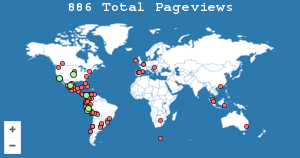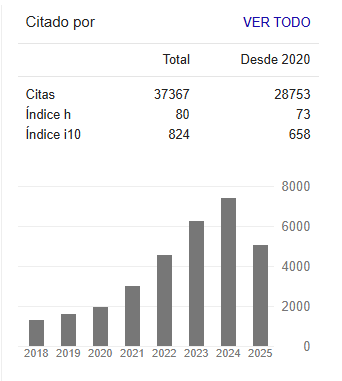Bases for a public policy on sustainable urban mobility during COVID-19
Resumen
Sustainable urban mobility is essential for the proper functioning of cities, favoring transportation models that consume fewer resources and generate lower environmental costs. In contexts of health emergencies such as the COVID-19 pandemic, it becomes especially relevant by allowing the establishment of the necessary social distancing to break the chain of contagion. The objective of this study was to characterize the current situation of urban mobility in the city of Trujillo, Peru, and establish bases for the design of relevant public policies and interventions during the pandemic. The methodology used was cross-sectional, descriptive, and with a mixed approach, applying surveys to a sample of 384 citizens and in-depth interviews with nine specialists. The data were processed with SPSS-26 and ATLAS.ti v9. As results, it was found that 83.3% of citizens are willing to use bicycles, 87.2% indicate the need to implement bike lanes, and 91.1% highlight that this type of mobility prevents the spread of COVID-19. It is concluded that there is a low preference for sustainable modes of transportation and a high dependence on private motorized transportation in Trujillo prior to the pandemic. However, there is a marked willingness among citizens to use bicycles if proper conditions are enabled, since it is perceived as an effective way to prevent contagion, reduce pollution, promote healthy habits, and facilitate labor accessibility. Therefore, it is suggested that there is an urgent need to formulate public policies aimed at promoting sustainable urban mobility, contemplating cycling infrastructure, awareness campaigns, and regulations that prioritize non-polluting and safe modes of transportation.
Citas
Albalate, D., Bel, G., & Gragera, A. (2022). Mobility, environment and inequalities in the post-COVID city. Cambridge Journal of Regions, Economy and Society, 15(3), 459–475. https://doi.org/10.1093/CJRES/RSAC021
Alcántara, E. (2010). Análisis de la movilidad urbana. Espacio, medio ambiente y equidad. Corporación Andina de Fomento. https://scioteca.caf.com/handle/123456789/414
Alourafi, S. N., & Alrawi, A. K. (2020). Integration urban land use planning with transportation planning: An evaluation toward sustainable transportation for the holy city of Karbala. IOP Conference Series: Materials Science and Engineering, 737(1), 012242. https://doi.org/10.1088/1757-899X/737/1/012242
Barbarossa, L. (2020). The post pandemic city: Challenges and opportunities for a non-motorized urban environment. An overview of Italian cases. Sustainability (Switzerland), 12(17), 1–19. https://doi.org/10.3390/su12177172
Blanco, N., &and Pirela, J. (2016). La complementariedad metodológica: Estrategia de integraciónde enfoques en la investigación social. Espacios Públicos, 19(45), 97–111. http://www.redalyc.org/articulo.oa?id=67646966005
Campisi, T., Basbas, S., Skoufas, A., Akgün, N., Ticali, D., & Tesoriere, G. (2020). The Impact of COVID-19 Pandemic on the Resilience of Sustainable Mobility in Sicily. Sustainability, 12(21), 8829. https://doi.org/10.3390/su12218829
Chen, T., Pan, H., & Ge, Y. (2021). Car ownership and commuting mode of the “original” residents in a high-density city center: A case study in shanghai. Journal of Transport and Land Use, 14(1), 105–124. https://doi.org/10.5198/jtlu.2021.1606
Duthie, J., Brady, J. F., Mills, A. F., & Machemehl, R. B. (2010). Effects of On-Street Bicycle Facility Configuration on Bicyclist and Motorist Behavior. Journal of the Transportation Research Board, 2190, 37–44. https://doi.org/10.3141/2190-05
Fallanca, C. (2020). The city of well-being. the social responsibility of urban planning. Smart Innovation, Systems and Technologies, 178 SIST, 346–355. https://doi.org/10.1007/978-3-030-48279-4_33
Ferreira, J. P., Isidoro, C., Moura Sá, F., & Baptista Da Mota, J. C. (2020). The economic value for cycling – a methodological assessment for Starter Cities. Hábitat y Sociedad, 13, 29–45. https://doi.org/10.12795/habitatysociedad.2020.i13.03
Fuster, D. E. (2019). Qualitative Research: Hermeneutical Phenomenological Method. Propósitos y Representaciones, 7(1), 201. https://doi.org/10.20511/pyr2019.v7n1.267
Gerencia de Proyectos de Transportes Metropolitanos de Trujillo. (2020). INFORME N°0226-2020-TMT-GP.
Gutiérrez-Gallego, J. A., and Pérez-Pintor, J. M. (٢٠١٩). Movilidad Urbana Sostenible en Ciudades Medias. El Caso del Campus de Cáceres. Revista de Estudios Andaluces, 37, 125–140. https://doi.org/10.12795/rea.2019.i37.06
Lange Valdés, C. (2011). Dimensiones culturales de la movilidad urbana. Revista INVI, 26(71), 87–106. https://doi.org/10.4067/s0718-83582011000100004
López-Olmedo, N., Stern, D., Pérez-Ferrer, C., González-Morales, R., Canto-Osorio, F., & Barrientos-Gutiérrez, T. (2020). Revisión rápida: probabilidad de contagio por infecciones respiratorias agudas en el transporte público y medidas para mitigarlo. Salud Pública de México, 1. https://doi.org/10.21149/11601
Lupano, J. A., & Sánchez, R. J. (2009). Políticas de movilidad urbana e infraestructura urbana de transporte. Documentos de Proyectos, 230(LC/W.230-P/E), 65 pp.
Mataix, C. (2010). Movilidad Urbana Sostenible: Un Reto Energético y Ambiental. https://www.fenercom.com/publicacion/movilidad-urbana-sostenible-un-reto-energetico-y-ambiental-2010/
Mateu, G., & Sanz, A. (2021). Public policies to promote sustainable transports: Lessons from valencia. Sustainability, 13(3), 1141. https://doi.org/10.3390/su13031141
Mera, A. Y., Tabares, E., Montoya, S., Muñoz, D. I., and Monsalve, F. (2020). Recomendaciones prácticas para evitar el desacondicionamiento físico durante el confinamiento por pandemia asociada a COVID-19. Universidad y Salud, 22(2), 166–177. https://doi.org/10.22267/rus.202202.188
Ministry of Housing Construction and Sanitation. (2016). Decreto Supremo que aprueba el Reglamento de Acondicionamiento Territorial y Desarrollo Urbano Sostenible. http://www3.vivienda.gob.pe/DGPRVU/docs/DUDU/01 RATDUS - DS 022-2016-Viviend.pdf
Motos, G. (2019). Analisis de indicadores de movilidad urbana sostenible. http://repositorio.upct.es/bitstream/handle/10317/7784/tfm-mot-ana.pdf?sequence=1&isAllowed=y
Narciso, S. (2020). Phenomenology as a qualitative research method: questions from the research practice. Revista Latinoamericana de Metodología de La Investigación Social., 20(10), 7–18. http://www.relmis.com.ar/ojs/index.php/relmis/article/view/fenomenologia_como_metodo/167
Nesmachnow, S., & Tchernykh, A. (2023). The Impact of the COVID-19 Pandemic on the Public Transportation System of Montevideo, Uruguay: A Urban Data Analysis Approach †. Urban Science, 7(4), 1–27. https://doi.org/10.3390/urbansci7040113
Nolan, J., Sinclair, J., & Savage, J. (2021). Are bicycle lanes effective? The relationship between passing distance and road characteristics. Accident Analysis and Prevention, 159(January 2020), 106184. https://doi.org/10.1016/j.aap.2021.106184
Pérez, G. G. (2020). Un jaque a la movilidad urbana sustentable en las ciudades de la confluencia . una mirada a esta problemática en tiempos de covid 19. Cuadernos de Investigación. Serie Economía., 9, 64–78. http://170.210.83.53/htdoc/revele/index.php/cuadernos/article/view/2972
Prieto-Curiel, R., & Ospina, J. P. (2024). The ABC of mobility. Environment International, 185(February). https://doi.org/10.1016/j.envint.2024.108541
Provincial Municipality of Trujillo. (2020). PMUS Plan de movilidad urbana sostenible de la ciudad de Trujillo (Vol. 01, pp. 1–359). https://www.munitrujillo.gob.pe/portal/otros/pmus
Rodríguez, M., Pinto Ayala, A. M., Bocarejo, J. P., Páez, D., Ortiz, M. Á., Ramos, J. P., Sarmiento, O. L., Morales, R., Pacheco, J., Márquez, F., Franco, J. F., Leal Vallejo, A., Vadillo Quesada, C., & Cantarella, J. (2017). Cómo promover el buen uso de la bicicleta. 40. http://www.iadb.org/es/proyectos/project-information-page,1303.html?id=RG-T2219.
Rosa, C. M., Henkes, J. A., & Graziano, L. A. G. (2020). As Diretrizes Do Plano De Mobilidade Urbana Do Município De Ribeirão Preto - Sp: Uma Análise Da Importância Da Promoção Do Transporte Coletivo E Dos Modos Não Motorizados. Revista Gestão & Sustentabilidade Ambiental, 9(2), 141. https://doi.org/10.19177/rgsa.v9e22020141-164
Sabino, A.-B., Reis-Martins, P., & Carranza-Infante, M. (2019). Experiencias y retos del uso de datos de aplicaciones móviles para la movilidad urbana. Revista de Arquitectura, 22(1), 82–93. https://doi.org/10.14718/revarq.2020.3039
Saglio, A., Robartes, E., Chen, T. D., Heydarian, A., Guo, X., & Angulo, A. V. (2023). Examining Socioeconomic and Physiological Factors Affecting Preferences for Cycling Infrastructure Using Virtual Reality Experimentation, 2677(12), 463–478. https://doi.org/10.1177/03611981231168834
Sánchez, D. A. (2018). Exploring the urban traffic space. Mapping the factors that affected the regulation and inspection of Lima’s urban transport system during the period 2007-2014. Politai: Revista de Ciencia Política, 9(16), 110–140. https://doi.org/10.18800/politai.201801.004
Sandoval, C. (2002). Especialización en teoría, métodos y técnicas de investigación social. In Módulo. ARFO Editores e Impresores Ltda. https://panel.inkuba.com/sites/2/archivos/manual colombia cualitativo.pdf
Singh, D. Z., Pérez, V., Hernández, C., & Velázquez, M. (2020). Movilidad pública , activa y segura . Reflexiones sobre la movilidad urbana en tiempos de mobility during COVID-19. Prácticas de Oficio: Investigación y Reflexión En Ciencias Sociales, 1(25), 67–84. http://revistas.ungs.edu.ar/index.php/po/article/view/34
Soto, K., & Gómez, J. A. (2020). Gobernanza y movilidad urbana hacia la sustentabilidad. Comunidad educativa en Monterrey, México. Bitácora Urbano Territorial, 30(3), 95–107. https://doi.org/10.15446/bitacora.v30n3.80196
Stanikzai, A. M., & Kajita, Y. (2017). Conventional Four Steps Travel Demand Modeling for Kabul New City. 11(10), 2414–2420. https://zenodo.org/records/1133059
United Nations. (2017). Transforming Our World: The 2030 Agenda for Sustainable Development. https://sustainabledevelopment.un.org/content/documents/21252030 Agenda for Sustainable Development web.pdf
Vanegas, A. Á., & Vanegas, A. Á. (2020). Movilidad urbana sostenible: ciudades benignas. Revista Universidad EAFIT, 55(175), 40–41. https://publicaciones.eafit.edu.co/index.php/revista-universidad-eafit/article/view/6452
Vega, P. (2018). Los planes de movilidad urbana sostenible en España (PMUS): dos casos paradigmáticos: San Sebastián-Donostia y Getafe [Universidad Complutense de Madrid]. https://dialnet.unirioja.es/servlet/tesis?codigo=229931&info=resumen&idioma=SPA
World Health Organization. (2017). Health and Human Rights. World Health Organization. https://www.who.int/es/news-room/fact-sheets/detail/human-rights-and-health
Zhang, Y., & Fricker, J. D. (2021). Quantifying the Impact of COVID-19 on Non-Motorized Transportation: A Bayesian Structural Time Series Model. Transport Policy. https://doi.org/10.1016/j.tranpol.2021.01.013

Esta obra está bajo licencia internacional Creative Commons Reconocimiento-NoComercial-CompartirIgual 4.0.








.png)






























